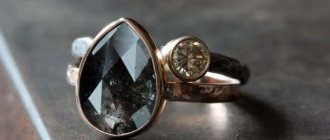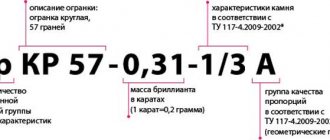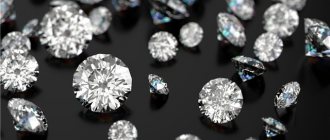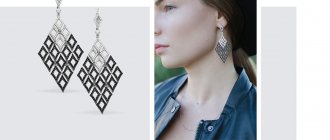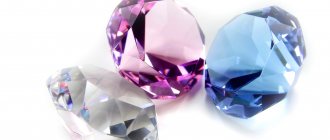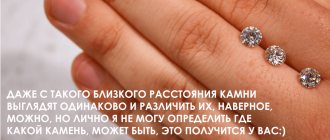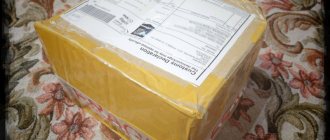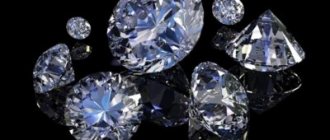We are glad to welcome you, our dear readers! You are on a page dedicated to the history of the famous stone called the Sancy diamond. Here you will find interesting information about the stone that made it a legend. Fans of mysterious romantic stories will definitely appreciate the legend behind the formation of this popular product.
This attractive teardrop shaped stone is light yellow in color. Thanks to the cut, you can trace its origin. Apparently, it was originally in India, but at some point in its existence it was brought to Europe. From that moment on, amazing things began to happen to him.
History of the Sancy Diamond
There are many versions about how the legendary jewel came to be. The author of the book “Diamond is a fragile stone” R. Valeeva reports one of the legends that are associated with its appearance. According to her, the first diamond was found in the eastern part of the Indian peninsula in 1064. The merchant who found it immediately realized that he could make good money from such a treasure. The merchant Jagattunga was able to exchange it for two large elephants, 12 camels and 80 gold. So the new owner of the stone weighing 101.4 carats became Sultan Vira Rajendra and his family.
Very soon the jewel, along with all the other treasures of the family, began to belong to Adhirajendra, who became the next Sultan. After this, the product belonged to several more famous families:
- Gulyamov dynasty.
- Qutb-ud-din.
The Sultan's treasury constantly passed from one owner to another along with the sansi, but one day the decoration disappeared. It is believed that the Grand Vizier stole it. After some time, information about it appears in connection with the Tughlaq family, when Sultan Muhammad acquired it in 1325 from a foreign merchant. Since then, India has not heard anything about this jewel. Most likely, from that moment the pebble came to Europe.
After a gap in history, when the whereabouts of the diamond were unknown, the European period of existence of this interesting piece of jewelry begins. In 1473 it became the property of Charles the Bold. Two years later, the diamond was processed by the famous polisher of the time, Ludwig Van Beurken, as a result of which the weight lost 48 carats, but gained 32 facets. Its next owner was the Portuguese king Afonso the African, who was forced to sell it. It is still unknown who the buyer of the Sansi was.
LiveInternetLiveInternet
Quote from TimOlya's message
Read in full In your quotation book or community!
The history of the SANSI diamond.
The history of the SANSI diamond
Ahmednagar fort
According to legend, this famous light yellow teardrop-shaped diamond was found in 1064 in eastern India by the merchant Jagattunga. Its original weight was 101.25 carats (20.25 grams). The merchant took the stone to the city of Ahmednagar (modern territory of the state of Maharashtra), where he exchanged it with the Maharajadhiraja of the Tamil state Chola Virarajendra for two young elephants, a dozen unbroken camels and eighty gold coins. In 1067, Virarajendra was succeeded by his son Adhirajendra and all the treasures of the dynasty, including the diamond, were inherited by him.
At the turn of the 12th – 13th centuries, the diamond was taken possession of by the malik (Arab ruler) of Lahore, Qutb ud-Din Aibek from the Gulyam dynasty, the creator of the world’s tallest brick minaret, Qutub Minar. But after some time, the gem disappeared from the treasury of the great ruler. Suspicion of theft fell on one of the viziers, but he did not say anything under mortal torture.
Qutb ad-Din Aibak
In 1325, the Delhi Sultan Fakhr ud-Din Abu-l-Fath Muhammadshah of the Tughlaqid dynasty purchased this diamond for a large sum from an unknown foreign merchant.
Then, for more than a century, the stone “kept silent.” Presumably, in 1473, he left India and moved to “old” Europe, settling in the treasury of the Duke of Burgundy, Charles the Bold.
Karl the Bold
There are several versions about the fate of the stone. According to one of them, Karl the Bold ordered the diamond to be split into three parts. The first two were presented as a gift to King Henry VI of England, who ordered his ring to be decorated with it, and to Pope Paul II, who assigned it a place in a velvet bag and always carried it with him on his belt. The part that the Duke kept for himself is the legendary “Sancy”.
The East has always been famous for its good craftsmen in processing precious stones. But Karl the Bold decided to trust European craftsmen. And he was not mistaken - the Flemish polisher and jeweler Ludwig Van Berken more than met the Duke’s hopes. He was the first on the European continent to double-cut a diamond, making thirty-two facets on it, while preserving its natural pear-shaped shape. The weight of the resulting diamond was 55.23 carats (11.046 grams). Charles the Bold ordered it to be inserted into his helmet.
Discovery of Charles's body after the Battle of Nancy
On January 5, 1477, in the decisive battle of the Burgundian Wars, the Battle of Nancy, Charles the Bold was killed. The diamond was found by a Swiss soldier. But he understood absolutely nothing about precious stones. After some time, the stone was taken from the soldier by his commander, who was also an amateur in jewelry and sold it to a Protestant priest for one guilder. The latter also made a fortune by selling a diamond to a Spanish merchant (wholesale merchant), earning three guilders for it. A subject of the Spanish monarch, in turn, sold the gem to the Portuguese King Alfonso Africanus, who repeatedly sold the diamond to moneylenders.
Afonso V the African
In 1570, the French attorney in Constantinople, Marquis Nicholas Harley de Sancy, purchased the diamond from the Portuguese autocrat, who fled to France from the Spaniards, for one hundred thousand French francs
Marquis de Sancy
It was believed that thanks to the stone, Sancy began a successful career and won the favor of the 28th and 29th kings of France, respectively, Henry III and Henry IV. The first borrowed a diamond from the Marquis to decorate his beret to hide his physical defect - baldness, and the second - to finance military operations
Henry III
Henry IV
According to legend, the faithful servant sent by the Marquis to deliver the gem to the king disappeared on the way to the palace. Sancy was firmly convinced that his servant was innocent of the loss of the diamond. And his intuition did not let him down. He personally conducted an independent investigation and found that the courier was attacked by robbers on the way. To prevent the bandits from getting the diamond, the servant, realizing that in any case he was risking his life, swallowed it. The embittered robbers, seeing that the prey was lost, killed the unfortunate man. Despite the fact that such devotion to the owner cost the servant his life, it was she who made it possible to preserve the stone, which was discovered during the autopsy in his stomach.
Around 1605, King James I of England and Scotland purchased the diamond in installments for sixty thousand crowns from the Duke of Sancy, who by that time already served as First Minister of France. It is believed that it was then that the stone got its name. In the same year, an inventory of all the jewels in the Tower of London was made and a catalog was compiled, in which the jewel was described as “a magnificent cut diamond, purchased from Sancy.”
James I (VI)
Over the next fifty years, the Sancy diamond was in the royal treasury of England.
The last of the Stuart dynasty then sold it, supposedly for 25 thousand English pounds, to His Eminence Cardinal Giulio Mazarin.
Giulio Mazarin
He, in his will, appointed King Louis XIV of France as the heir to the stone, who ordered it to be placed on the agraf (pin) of his royal hat. Then, from September 4, 1725, the Sancy diamond was used as jewelry by the wife of Louis XV, Queen of France Marie Leszczynska.
Louis XIV
Maria Leshchinskaya
The next French monarch, Louis XVI, first inserted a diamond into the crown. But then, like his predecessor, he could not resist the persuasion of his wife, Queen of France Marie Antoinette, who heard rumors that the stone was in seventh place in size and first in historical significance on the “European Diamond List”. He ordered to decorate his wife’s fan with it.
Louis XVI
Sancy adorning the royal crown
Marie Antoinette, Queen of France
(1755-1793)
In 1792, during the French Revolution, the stone was stolen along with other jewelry from the royal treasury of Garde-Meuble. Hot on the heels of “Sancy”, like other famous diamonds “French Blue”, (“Pitt”), it was not possible to find.
At one time, the French Emperor Napoleon Bonaparte had an interest in the Sancy diamond. But even one of his experienced secret agents, nicknamed Bleiweis, did not help him take possession of the treasured treasure.
In 1828, rumors spread throughout Paris that unknown people were looking for a buyer for the original Sancy, offering to first evaluate its glass copy. They looked for a buyer for a long time, because the stone was on the French wanted list and the prospect of hard labor did not appeal to anyone. But this did not stop the Russian entrepreneur, owner of the richest Ural iron smelting plants, Pavel Demidov, who purchased the diamond for eighty thousand British pounds sterling.
Pavel Nikolaevich Demidov
The jewel was intended as a wedding gift to P. Demidov’s bride Aurora Karlovna Shernval.
Aurora Karlovna Demidova
The French government was not happy with this development of events and filed a lawsuit to annul the deal until the identity of the seller of the diamond was clarified. Pavel Demidov felt that the stone might slip out of his hands and bribed the Duchess of Berry Marion Bourguignon. At the trial, for a “reward” of one hundred thousand francs, she gave the “necessary” testimony, according to which the stone was allegedly given to her by Marie Antoinette, that it was her property, and she could dispose of it at her own discretion as she pleased. The jury found the duchess's evidence convincing and recognized the legality of the deal. After this, Pavel Demidov took the stone to Russia.
Duchess of Berry, Elisabeth Vigée-Lebrun
In 1865, the widow of Pavel Demidov, Aurora, sold “Sancy” for one hundred thousand English pounds sterling to the merchant and philanthropist first baronet Sir Jamsetjee Jejeebhoy, and a year later he sold it to the buyer, who wished to remain anonymous
Aurora Karlovna Demidova-Karamzina
In 1867, the diamond was exhibited at the 4th World Exhibition on the Champ de Mars in Paris. The owner of the stone estimated its value at one million French francs.
In 1906, the American industrialist William Waldorf Astor bought the diamond as a wedding gift for his son (the founder of the British branch of the Astor family).
Lord Astor
Portrait of Lady Nancy Astor
His daughter-in-law Nancy (who would later be the first female member of the British Parliament in British history) decorated his tiara with him. The famous Astor family, one of the largest representatives of the American bourgeois aristocracy of the 19th and early 20th centuries (along with the Rockefellers and Vanderbilts) owned the relic for 72 years. In 1978, the fourth Viscount of the Astor family, William Waldorf Astor, decided to sell the stone to the state for one million US dollars. Since then, the famous diamond has been an exhibit of the Apollo Gallery in the Louvre.
Where did the name Sancy come from?
The jewelry got its name when diamonds began to be held in special esteem among the European nobility. A Turkish jeweler sold the piece to a French attorney in Constantinople named Nicolas de Sancy. He became the most famous of all the owners of this jewelry, so he began to be associated with the name of this person.
It is surprising that immediately after the new acquisition, Sancy made a dizzying career for himself. Many noble people of that time saw a magical meaning in this, so the aristocracy and members of the royal family dreamed of owning this stone. Mr. Sancy was able to gain the favor of King Henry 3 when he lent him a jewel to decorate his headdress. As you know, this king constantly wore berets to cover the bald spot on the back of his head.
The struggle for the right to own this jewel was very serious. According to one legend, Sansi's servant was supposed to one day deliver an object to the king, but on the way he disappeared. The owner could not believe in the servant’s dishonesty, so he used all his strength to search for this man. It turned out that he was killed by robbers. When the servant's body was opened, a diamond was found in the stomach. It turned out that in this way the loyal subject wanted to deprive the robbers of the opportunity to own the jewelry.
The diamond began to be called by its name when its owner sold the jewel to King James 1 of England. In 1605, in the catalog of the acquisition of the Tower, this stone was recorded as “a magnificent diamond purchased from Sancy.” At that time, its former owner managed to take advantage of the “magical power” of the jewelry and become the first minister in the history of France.
Ram, eagle and diamonds...
What kind of “pebble” was this? They say that he was “born” in Eastern India, where mountain streams from time to time washed away large diamonds from durable rock. Then they settled in the depths of the gorges, from where there was absolutely no way to get them. Firstly, the descent is very dangerous due to the steep cliffs, and secondly, poisonous snakes lived in huge numbers at the bottom of the gorges. But people would not be people if they had not come up with a clever move. As soon as the diamond began to sparkle from the day of the river, they threw a ram down from a height of many meters, trying to make it fall straight onto the diamond. The ram, naturally, broke, but the diamond sometimes “got stuck” in its thick fur.
There was very little left to do - wait until the carcass of the dead animal was spotted by an eagle. The “King of the Air” made a sharp turn, grabbed the ram, and as soon as he rose to the level of the mountain path, the shooters were waiting for him. The eagle threw the ram, people immediately ran up to the latter in the hope of “picking out” the diamond. I wasn't always lucky, but sometimes luck smiled.
This, at least, was the case with a large diamond that was found at the end of the 11th century by one of the merchants. It was as if he had a presentiment that such a large diamond (weighing more than 100 carats) would not lead to good, and acted very wisely by selling it in the first city. And then the precious stone began to pass from hand to hand, increasing the number of deaths of its owners. Moreover, there were cases when the son did not stop before killing his father, just to take possession of the diamond. For almost four centuries, the “toy” weighing 100 carats was in the East...
What is the further fate of the pebble?
For more than 500 years, the famous decoration was part of the royal treasury of England. The further fate of the diamond is connected with the following historical events:
- When a coup occurred in England, the Stuart dynasty lost its power. It was decided to sell the product to Cardinal Mazarin. The sale price is considered to be 25 thousand pounds. After his death, it was bequeathed to Louis 14 and his family.
- The Great French Revolution again changed the location of the jewel. As a result of the robbery, the royal family lost many things that had been their possession for many years. Among the stolen items from the royal treasury was Sancy.
- Until 1828, nothing was known about the decoration, until it was put up for sale and bought by Pavel Demidov. So the decoration became part of Russian history. For what reason the Demidovs decided to resell the product in 1865 remains only a guess. But so the Indian Raj became its new owner, who sold the purchase to an unknown person a year later.
- The World Exhibition in Paris in 1867 became famous for the presence of a magnificent piece of light yellow color. Experts estimated the cost of the decoration at that time at a million francs. After the exhibition, the diamond disappeared from view for 40 years.
- It is unknown how the stone got into the Astor family collection, but it happened in 1906. For more than 70 years, members of the Astor family carefully passed on the jewel, but it would eventually be sold to the Louvre by the fourth Lord Astor.
History of stone and Russia
When Pavel Demidov became the owner of the jewelry, Russia’s connection with the history of this wonderful stone began. According to legend, it was given by Demidov to his beloved Aurora Shernval. She loved to be in solitude in her villa in Helsingrfors (modern Helsinki). The name of this girl was already associated with a sad curse. All her suitors died before the wedding.
This reputation greatly frightened Pavel Demidov’s friends, who dissuaded him from even approaching this girl. But he was not one of those who believed in curses. He was not even frightened by the story that the Sansi diamond had previously been owned by Arab kings, and it was an adornment of one of the Indian gods in the temple. The entrepreneurial spirit and fearlessness helped Mr. Demidov get both the jewel and the beautiful wife.
Saint Helena instead of Sancy...
...But let's return to Napoleon Bonaparte. He was very partial to jewelry, and was sure that “Sancy” could not be hidden like an awl in a sack. Having learned that a precious stone very similar to the one being sought was offered for sale in Vienna, he sent his most experienced spy to the banks of the Danube. Suffice it to say that Mr. Bleiweis appeared in Vienna in the guise of a French prostitute. Moreover, he managed to get to the auction for the sale of this precious stone, but it turned out that it was not “Sancy” at all.
Where do you think he surfaced later? Naturally, in Paris. In order to leave for... Russia, because it was acquired by the Russian industrialist and entrepreneur Nikolai Demidov, who owned the Ural copper smelters. This happened in 1830, when Bonaparte was no longer alive.
The French did not really want to part with the diamond, and by hook or by crook they tried to prove that Demidov’s deal with the Parisian broker was illegal. But Nikolai Nikitovich turned out to be not at all the kind of person who could be eaten without salt. Moreover, starting from 1815, he lived almost constantly in Florence, where he was the Russian envoy. He found a representative of an ancient French family, who at the trial, under oath, said that the diamond once belonged to her grandmother, who received it as a gift from Louis XVI. Few people believed it, but the duchess’s reputation was without a single blemish. I had to put up with the fact that “Sancy” would go to the Russian Empire.
Further reading[edit]
- Balfour, Ian (2009). Famous Diamonds
5th ed. Antiques Collectors Club LLC ISBN 978-1851494798 - Burton, E. (1986). Legendary Gems or Gems That Made History
, pp. 78–83. Chilton Book Company, Radnor, Pennsylvania - Fowler, M. (2002). Hope: The Adventures of a Diamond
, pp. 100, 151, 321. Random House Canada - Ronald, S. (2004). Blood Diamond of Sancy: Power, Greed, and the Cursed Story of One of the World's Most Coveted Gems
. Wiley & Sons. ISBN 978-1620457191 - Shipley, R. (1939). Famous Diamonds of the World
, pp. 24–27. Gemological Institute of America, USA - Shipley, Robert (1934). Famous Diamonds of the World
, pp. 25–28. Gemological Institute of America, USA, Vol. 1, No. 6 (November – December)
"Sweet Josephine"
Another rare type of diamond, it combines an intense pink color and a high degree of transparency. The stone is cushion cut and set in a gold and platinum ring with small white diamonds.
Put up for auction in 2015 at Christie's. The 16.08-carat diamond was purchased by Chinese billionaire Joseph Lau for $28.5 million. The stone was purchased as a gift to her seven-year-old daughter, in whose honor it was later renamed The Sweet Josephine.
Interestingly, over the past 250 years, only 3 Fancy (deep pink) diamonds weighing more than 10 carats have been offered for sale.
"Aurora Green"
It is no coincidence that this stone is included in almost all ratings of the most famous and beautiful diamonds. It has a rare green tint, which is why it is so prized by collectors and jewelers.
In 2016, the jewel was put up for auction at Christie's. As a result, it was purchased by a famous jeweler for a colossal sum of $16.8 million.
Aurora Green is far from the largest stone - its weight is a little more than 5 carats, that is, a little more than 1 gram. The stone is used to create the "VS2" ring, in which it is surrounded by pink diamonds and gold.
Green diamonds are considered rare and are also difficult to obtain. The fact is that when a mineral is extracted from the earth under the influence of sunlight, it can change color. Therefore, initially green diamonds often turn yellow or red.
Black Diamond Orlov
Also known as the "diamond eye of Brahma". In India, a 195-carat black diamond, according to legend, adorned the eye of a statue of the god Brahma near Pondicherry (South India). Perhaps such a biography, as well as the rare black color, would explain all the rumors about the curse, if some of its owners did not commit suicide. The first was Jay Paris, who brought the diamond to America in 1923. Some time later, he jumped from one of the New York skyscrapers. The next owners, Nadezhda Orlova and Princess Galitsina-Baritanskaya, also allegedly committed suicide in 1947. It is difficult to say how true these stories are - the archives avoid mysterious deaths.
According to documents, Princess Galitsina-Baritanskaya died at the age of 102 in Switzerland in 1918, and Nadezhda Petrovna Orlova at the age of 90 in France in 1988. Subsequently, the stone changed many more owners, the most famous of them is the jeweler Denis Petimezas, who bought the stone in 2004. He publicly stated that he did not feel any effect of the notorious curse, and the diamond brought him nothing other than good luck. However, after 30 months he put it up for sale. In 2006, “black Orlov” found a mysterious buyer, according to the media, “from another continent,” whose name and fate are unknown to the public.
Diamond Centenary - Centenary
This gemstone holds a “bronze” place in the ranking of the most luxurious and expensive diamonds. The weight of the stone was 274 carats, the brilliance of which is reflected in 274 facets. This gem is the youngest: it was found only in 1986. And surprisingly, in the same mine where Cullinan was once found. The diamond was presented in 1988 at one of the social events dedicated to the anniversary of the de Bris corporation. And since the anniversary was a centenary, the stone got its name, which translates as “century”. The diamond had a very complex shape, so jewelers spent 3 years studying the structure of the crystal to decide how best to process it in order to preserve its original beauty as much as possible. The research was carried out in a special bunker, entry to which was strictly limited. To ensure that the cutting is carried out to the highest possible quality, scientists have created unique equipment. And by 1991, the final processing of Centerini was completed. In May 1991, Centenary was exhibited at the Tower of London, after which the American Gemological Institute awarded the stone the highest ratings for clarity and color. The future fate of the third largest diamond in the world remains unclear. It is not known exactly where the diamond is located now. One can only guess who she sold it to. According to rumors, the stone, insured for $100 million, was purchased by the British royal family. Whether this is true or not is not known for certain.
Diamond Golden Jubilee
The largest diamond (cut diamond) in the modern world is the Golden Jubilee. The found diamond weighs 755 carats and ranks 8th in size among all gem-quality diamonds ever discovered. The diamond did not have any name, so it was simply called the Nameless Brown Diamond. Under this name, the stone was shown at several exhibitions, including the Thai Board of Investment exhibition, where it was brought by the Thai Diamond Manufacturers Association. The exhibition was a great success; large queues lined up to see the unusual diamond.
The diamond got its name in honor of King Bhumibol Adulyadej (Rama IX) of Thailand. The stone was presented to the king by his subjects in 1997 in honor of the 50th anniversary of his coronation. In addition to being the largest diamond, the Golden Jubilee is also the largest brown diamond in the world.
Thailand is one of the few countries in the world where the political system is a constitutional monarchy, and the ruling king enjoys great authority. In 1997, Thailand was preparing to celebrate the 50th anniversary of the reign of its beloved king and a group of businessmen, led by the famous diamond seller Henry Ho, decided to present a diamond as a gift to the monarch. In 1995, the diamond was purchased from De Beers and exhibited at the Henry Ho jewelry shopping center in Bangkok. Before the presentation, the diamond was shown to Pope John Paul II, the Supreme Buddhist Patriarch and Supreme Muslim Imam of Thailand, and received their blessing.
It should be noted that Thailand was experiencing an economic crisis at that time, and in order not to worry fellow citizens, the government announced that the gift received was not a diamond, but a large golden topaz. There were plans to set the stone into a royal scepter or royal seal, but for now it remains unmounted. The world's largest Golden Jubilee Diamond is currently on display in the Throne Room of the Golden Temple at the Royal Museum in Bangkok.
Links[edit]
- ↑
Ogden, Jack (8 May 2022). Diamonds: The Early History of the King of Gemstones. paragraph 76. ISBN 978-0-300-23551-7. OCLC 1030892978. - Jump up
↑ Balfour, Iain (2009).
Famous Diamonds (5th ed.)
. LLC "Antiques Collectors Club" p. 244. - Jump up
↑ Brewer, Ebenezer Cobham (1906). Character Sketches of Novels, Fiction and Drama, Volume 3. Minerva Group. item 347. ISBN 9781410213358. Retrieved July 1, 2012. CS1 maint: discouraged parameter (link) - Harlow, George E. (1906). The nature of diamonds. Cambridge University Press. paragraph 107. ISBN 9780521629355. Retrieved July 1, 2012. CS1 maint: discouraged parameter (link)
- RONALD, SUSAN. "The Sancy Diamond - New Facts". https://www.thesancydiamond.com. Archived from the original on June 23, 2012. Retrieved July 1, 2012. External link in |publisher=(help)CS1 maint: discouraged parameter (link)
- Williams, Gardner Fred (1906). Diamond mines of South Africa. B. F. Buck & Company. paragraph 24. Retrieved May 16, 2012. CS1 maint: discouraged parameter (link)
- HMC Salisbury Hatfield
, vol. 17 (Edinburgh, 1938), pp. 91-2. - F. Palgrave ed., Ancient Kalendars of the Exchequer, vol. 2 (London, 1836), p. 305.
